The AMD Ryzen 9 7900, Ryzen 7 7700, and Ryzen 5 7600 Review: Zen 4 Efficiency at 65 Watts
by Gavin Bonshor on January 9, 2023 9:00 AM ESTCPU Benchmark Performance: Rendering And Encoding
Rendering tests, compared to others, are often a little more simple to digest and automate. All the tests put out some sort of score or time, usually in an obtainable way that makes it fairly easy to extract. These tests are some of the most strenuous in our list, due to the highly threaded nature of rendering and ray-tracing, and can draw a lot of power.
If a system is not properly configured to deal with the thermal requirements of the processor, the rendering benchmarks are where it would show most easily as the frequency drops over a sustained period of time. Most benchmarks in this case are re-run several times, and the key to this is having an appropriate idle/wait time between benchmarks to allow for temperatures to normalize from the last test.
One of the interesting elements of modern processors is encoding performance. This covers two main areas: encryption/decryption for secure data transfer, and video transcoding from one video format to another.
In the encrypt/decrypt scenario, how data is transferred and by what mechanism is pertinent to on-the-fly encryption of sensitive data - a process by which more modern devices are leaning to for software security.
We are using DDR5 memory on the 12th and 13th Gen Core parts, as well as the Ryzen 7000 series, at the following settings:
- DDR5-5600B CL46 - Intel 13th Gen
- DDR5-5200 CL44 - Ryzen 7000
- DDR5-4800 (B) CL40 - Intel 12th Gen
All other CPUs such as Ryzen 5000 and 3000 were tested at the relevant JEDEC settings as per the processor's individual memory support with DDR4.
Rendering
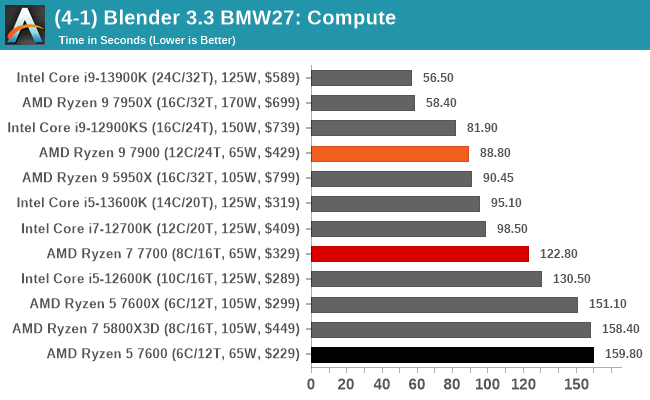
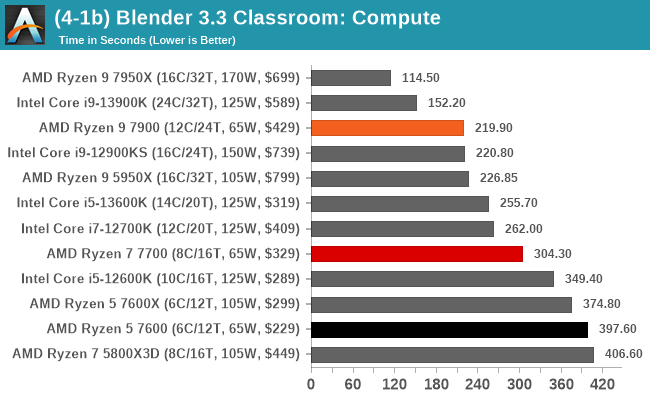
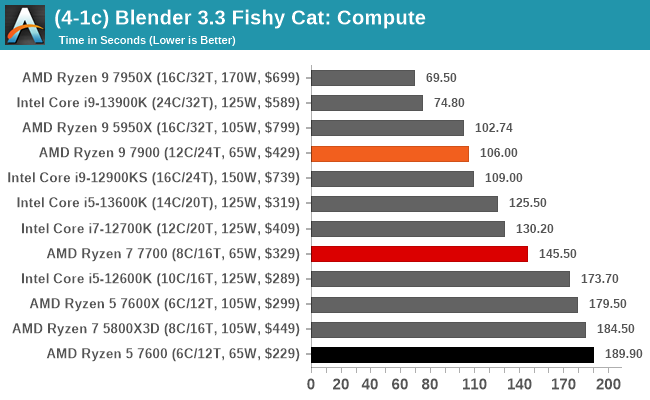
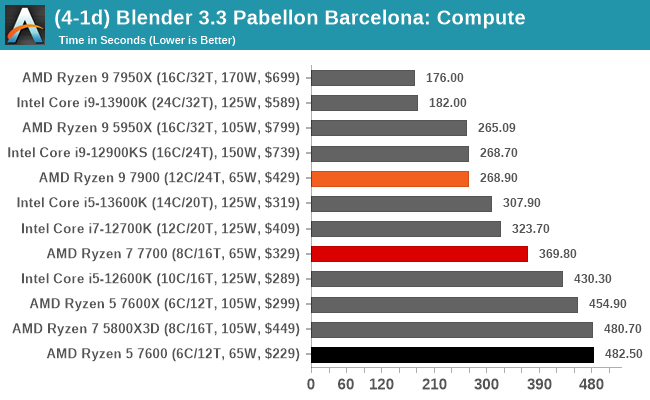
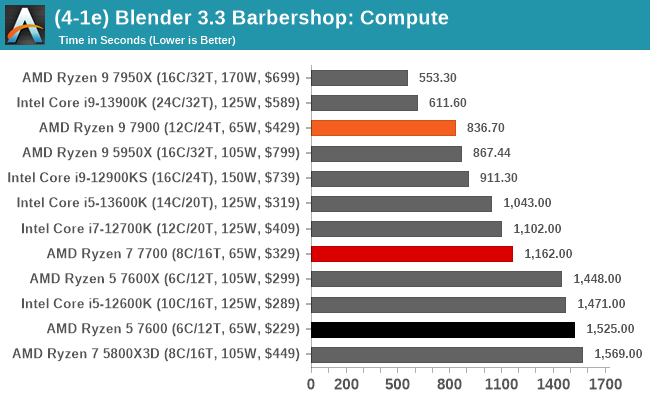
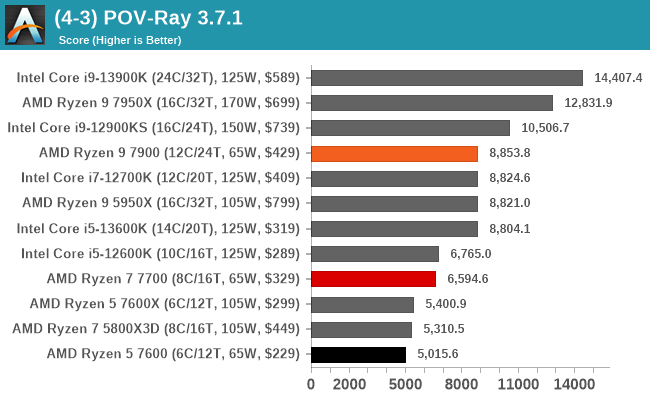
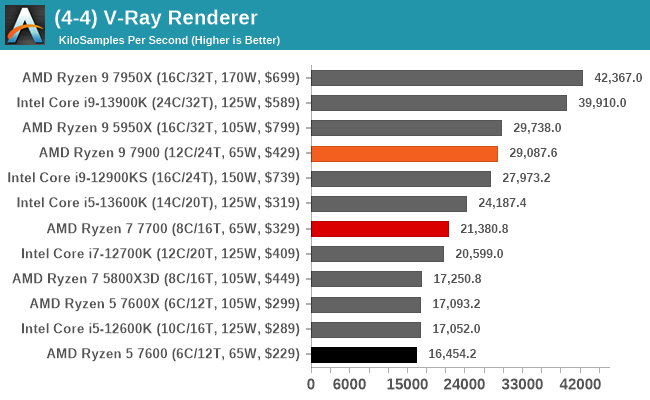
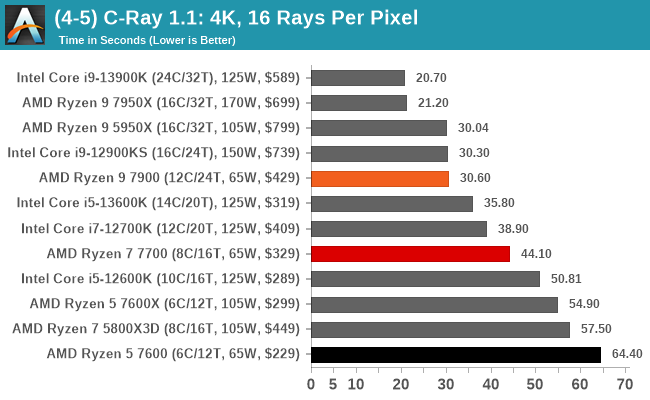
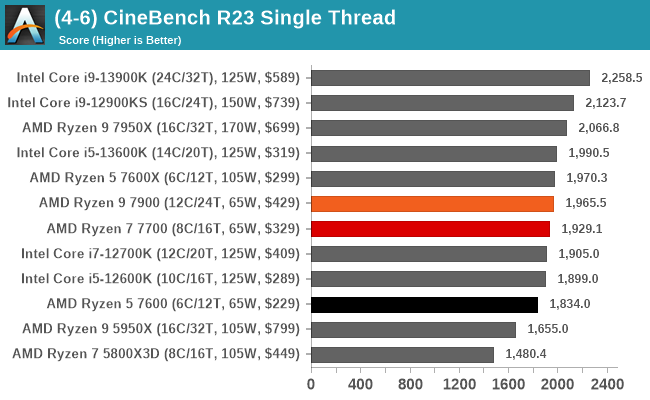
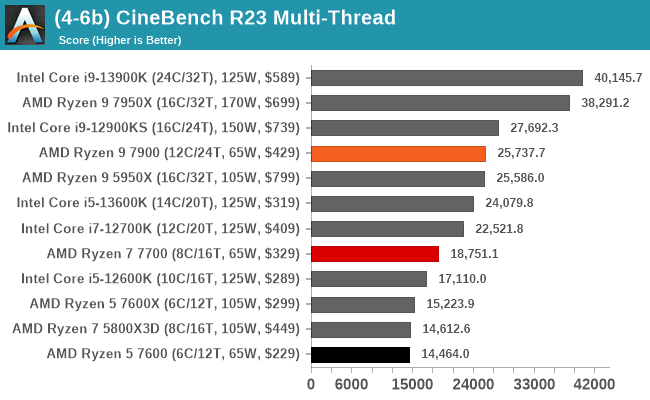
Focusing on rendering performance, the entry-level Ryzen 5 7600 starts to fall behind in comparison to the other SKUs. Even in terms of CineBench R23 single-threaded performance, it sits below Intel's 12th Gen Alder Lake chips (albeit in a very packed field). Meanwhile in the multi-threaded test, it is blown away by the parts with 10 cores and above.
The real surprise is how well the Ryzen 9 7900 performs, as it is consistently better than the previous generation Ryzen 9 5950X, and even trades blows with the Intel Core i9-12900KS processor in quite a few tests. The Ryzen 7 7700 also performs well, but with just 8C/16T, and at 65 W, it basically bridges the gap directly in the middle between the Ryzen 9 7900 and the Ryzen 5 7600.
Encoding
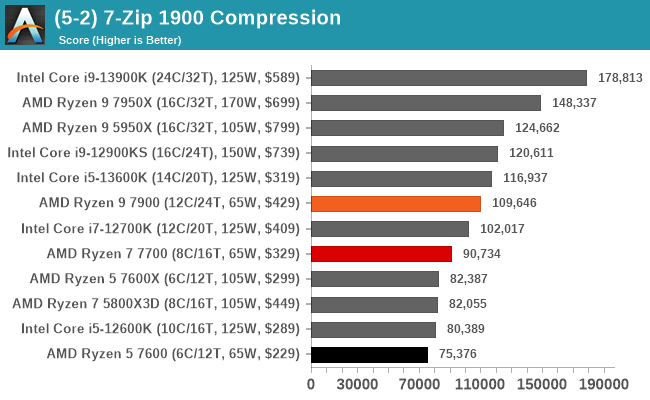
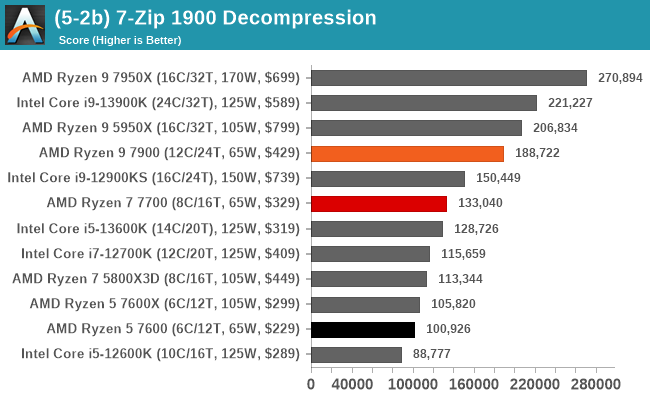
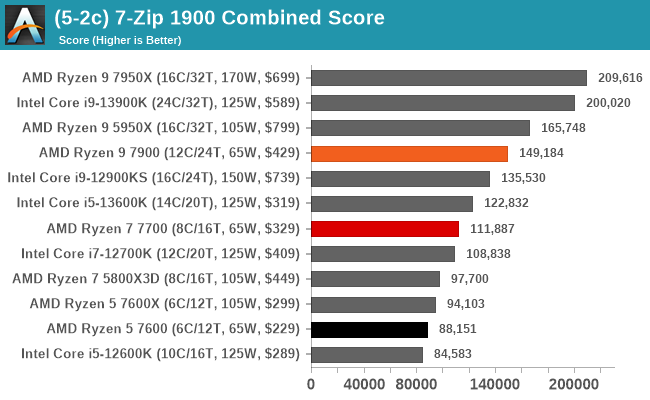
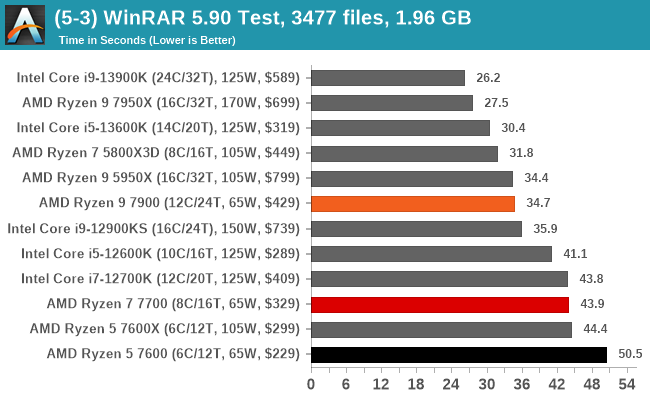
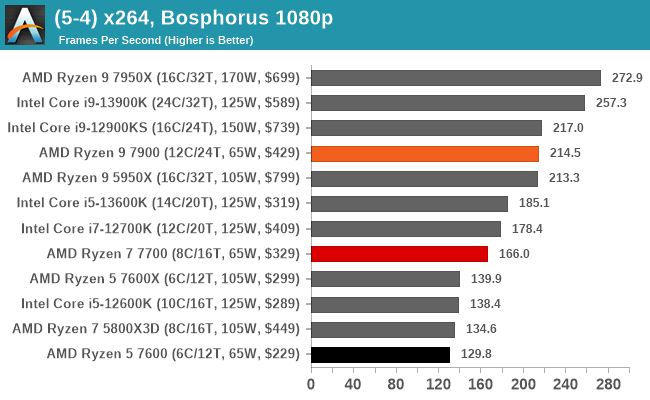
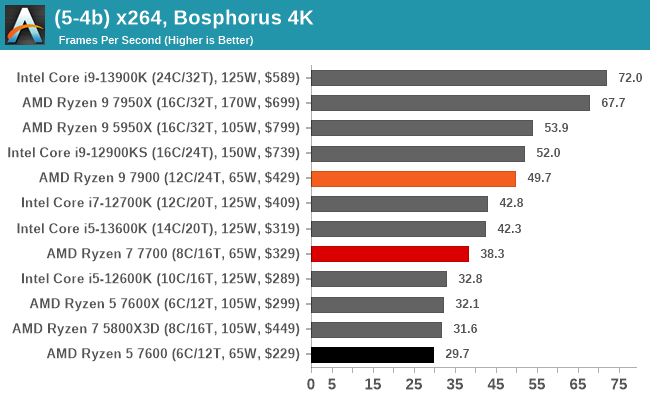
As we saw in our rendering tests, the same thing can be said about performance in encoding. The Ryzen 9 7900 offers the highest levels of performance (as expected), with the Ryzen 5 7600 being one of the slowest chips we've tested so far since we updated our test suite for 2023. The Ryzen 7 7700 once again bridges the gap between the other two Ryzen 7000 65 W SKUs.
Despite not offering world-beating levels of performance, all three chips are running with a 65 W TDP and given the results, even the Ryzen 5 7600 performs above our expectations here.










55 Comments
View All Comments
bcortens - Monday, January 9, 2023 - link
Does sustained power consumption look similar to peak power consumption?Why does your article lead with "Efficiency at 65 Watts" when the peak power is 90 Watts?
AshlayW - Monday, January 9, 2023 - link
Because the Platform Power Target (PPT) for '65W TDP' models from AMD has always been around 87W (~90 give or take). The TDP is thermal watts for cooling systems not sustained electrical watts for power usage. I assume the author is implying that the models are the AMD-rated 65W TDP and are efficient, not that they specifically use 65 watts, but I suppose it's kinda misleading.meacupla - Monday, January 9, 2023 - link
yeah, not all the electrical energy going into the chip ends up as heat energy.saratoga4 - Monday, January 9, 2023 - link
All of the electrical energy going into the chip does become heat aside from a tiny bit that leaves as bits on the various buses (which is mostly canceled out by energy coming in from other chips on the same bus). The difference between TDP and peak power is that the CPU can thermally throttle if needed.ballsystemlord - Monday, January 9, 2023 - link
A CPU is not a resistor. So not all the energy is converted into heat.For example, some of it goes down the PCIe bus, and heats up the PCB traces and PCIe card. Likewise with the RAM.
Samus - Wednesday, January 11, 2023 - link
Intel and AMD have dramatically different packaging. The TDP designation in AMD CPU's applies to the CPU portion of the package ie ZEN core chiplet(s) while the IO CCD is rolled into the PPT as it is effectively the rest of the "platform."If we were to try comparing fruits, AMD's PPT would be comparable to Intel's TDP + chipset (Z690 is 6-watts) + other external components that would otherwise be integrated in a Ryzen IO but as these architectures are vastly different a direct comparison is impossible; for example, AMD's IO is far more complex than Intel's, supporting a wider range of platform designs and IO types. While Intel and AMD both support DDR4\5 at this point within their memory controllers, PCIe 3.x\4.x\5.x is handled inside of AMD's IO while Intel offloads much of that to the chipset, only supporting some lanes inside the CPU, and many CPU's not supporting 5.x. To make matters worse, the Z690 is manufactured on a 14nm process while AMD's IO CCD is 7nm (or something like that) so while the Z690 would use much more power if it did the same thing as the AMD IO CCD, it doesn't. In fact it does very little and the package itself is tiny like 25mm2. This means the AMD IO handles a lot more while being 7nm while Intel integrates all of that into the CPU die which is a more refined 10nm process that efficiency is somewhere between TSMC 5nm and 7nm.
Basically AMD's CPU CCD (5nm?) is more efficient while their IO (7nm?) is less efficient and this doesn't entirely balance out compared to Intel's monolithic 10nm (which more efficient than TSMC's 7nm.)
This chart breaks it down better than I can - scroll down to density comparison: https://www.granitefirm.com/blog/us/2021/12/28/tsm...
ballsystemlord - Thursday, January 12, 2023 - link
It's unclear to me how this relates to my post.I was saying that not all the power is turned into heat, therefore, the 90w figure is not misleading.
ballsystemlord - Monday, January 9, 2023 - link
Also worth noting is that the power dissipated is related to the resistance of the component, not the amount of power going into the component. You should recall that from any basic series circuit you have worked with/on.escksu - Tuesday, January 10, 2023 - link
It's true that it's related to resistance but in the case of the cpu, it's mostly due to the rapid switching of transistors.escksu - Tuesday, January 10, 2023 - link
Not all but most of becomes heat. It's due to the rapid switching on/off of the transistors.